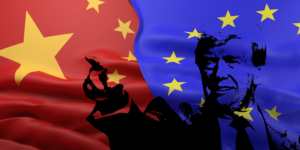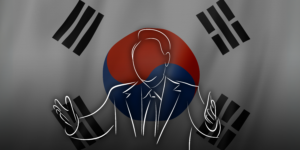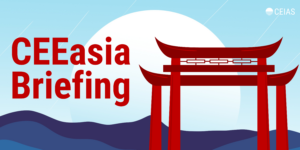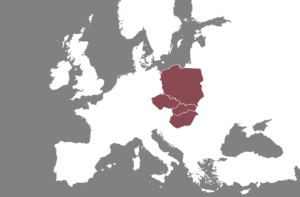The year 2019 marked a critical shift in the relations of the European Union (EU) with the People’s Republic of China (PRC): in its blueprint for a new China strategy the EU presents China in a much more critical light than in previous strategy papers. While China is regarded as a partner with whom a balance of interests needs to be found and economic competitor, it is also—for the first time ever—viewed as “a systemic rival promoting alternative models of governance” (European Commission and High Representative 2019: 1).
Before 2019, the EU applied an economic rather than geostrategic lens in its relations with Beijing. It did not side with the Trump administration in its trade war against China, because it relies economically on both countries and thus did not want to take a side in this conflict. Instead, Brussels promoted economic multilateralism and supported China’s aim to reform the World Trade Organisation (WTO) (Garcia Herrero 2019: 417). The EU seemingly applied Germany’s soft “Change through Trade” approach toward China. The idea behind this concept is that authoritarian regimes will open up economically and eventually even politically due to the increased economic exchange. However, in regard to China (but also Russia), this approach failed. Even the bilateral economic relations became tense, symbolized in the non-ratification of the Comprehensive Agreement on Investment (CAI) by the European Parliament.
Even though Brussel’s three-pronged approach toward China as partner, competitor, and systemic rival continues to define the EU’s China strategy, the focus has increasingly turned to China as a powerful adversary and means to respond to this challenge. Accordingly, the EU’s stance and policies toward China have further hardened, culminating in the promotion of a de-risking strategy. Introduced by the President of the EU Commission, Ursula von der Leyen, in her speech on EU–China relations in March 2023, this strategy seeks to reduce risks stemming from the EU’s economic dependencies on the PRC and to strengthen the EU’s resilience (von der Leyen 2023).
Moreover, already in 2021, the EU launched the Global Gateway Initiative (GGI), its ambitious infrastructure and connectivity scheme. The GGI is an important geo-economic project: Until 2027, the EU plans to spend up to 300 billion Euros in quality infrastructure around the globe, ranging from the transport to the digital and health sector. The EU thus offers developing nations at least in some areas an alternative to China’s Belt and Road Initiative (BRI).
The BRI and the China-led Cooperation between China and Central and Eastern European Countries (China-CEEC cooperation)—also known as the 14+1; formerly 17+1 from 2019-2021 and 16+1 from 2021-2022—were key drivers for the EU’s increasingly critical perception of China (Pavlićević 2019: 453-454).
16+1 as a bone of contention
The China-CEEC cooperation was established by China in 2012 as a multilateral forum to promote its relations with Central Eastern European and Western Balkan nations. In addition to summits with heads of government, there are also regular meetings of ministers, senior officials, business people, and civil society representatives. Cooperation within the China-CEEC is not limited to economic endeavours related to infrastructure and connectivity, but also includes initiatives related to culture, education, and tourism. Notwithstanding certain multilateral elements, the China-CEEC cooperation is basically an umbrella for China’s bilateral approach, as Beijing negotiates the main BRI projects with each member individually (Kavalski 2019: 4-8).
Concerns about the China-CEEC cooperation were first raised within the EU in March 2019, when Italy—a founding member of the EU and a member of the G7— signed a Memorandum of Understanding with Beijing on the BRI. However, subsequent Italian governments, including the current centre-right coalition government led by Giorgia Meloni, have been critical of this MOU and its renewal in March 2024 is highly unlikely. Since signing the MOU with China, Italy’s trade deficit with China grew even further, while Chinese companies invested less in Italy. (Sacks 2023). Then, in April 2019, Greece joined the China-CEEC cooperation, expanding its membership from 16 to 17.
One of the main reasons for the EU’s critical view of China–CEEC cooperation is that twelve of the seventeen European participants are also EU members. Thus, there were fears that China, due to its close relations with certain members, would indirectly sit at the EU table. Indeed, in July 2016, Greece and Hungary watered down an EU statement on the South China Sea award of an Arbitral Tribunal of the Permanent Court of Arbitration. In this award, the Tribunal ruled that there is no legal basis for China’s so-called nine-dash line. This line, in fact nine dots drawn on a map, covers up to 90 percent of the territoriy of the South China Sea. In its statement, the EU merely acknowledged the award but neither offically welcomed nor supported it. The latter would have been interpreted as diplomatic support for the Southeast Asian claimant nations, in particular the Philippines which initiated the legal arbitration in 2013. Accordingly, China would have responed with sharp criticism of the EU. Hungary even issued a separate statement on the award, and, in doing so, “effectively broke ranks and violated EU discipline to support China” (Fallon 2016).
Another issue of concern is the high strategic significance of the Western Balkan states, many of whom are China-CEEC cooperation members, for the EU. These Western Balkan governments are willing to join the EU, but are dissatisfied with the slow progress of accession talks. While Brussels is to keen reduce China’s footprint in the Western Balkans, it faces competition for influence in the region from the US, Russia, and Turkey. Serbia, in particular, is both China- and Russia-friendly, despite its close economic relations with the EU.
Two of the most contested BRI projects in Europe are carried out in China-CEEC cooperation member states: the delayed and economically questionable Budapest–Piraeus high-speed railway and a costly, oversized highway project in small Montenegro. The Chinese state-owned COSCO holds a majority stake in the Greek port of Piraeus, which is only one of many strategically important European ports which Chinese companies control or hold a stake in (e.g. Genua and Trieste in Italy or Antwerp-Bruges in Belgium). COSCOS’s 24.9 percent share in a container terminal of the port of Hamburg is extremely contested, because it is regarded as critical infrastructure (von der Burchard 2023). Even politicians in the ruling coalition warned of risks to Germany’s national security and economic interests. However, there are also limits to China’s influence in Europe, even in Victor Orbán’s “illiberal” Hungary. For example, the prestigious project to open a campus of Fudan University in Budapest by 2024 has stalled due to public criticism in Hungary.
Criticism on China and closer ties with Taiwan
Concerning for China is the growing criticism of China-CEEC cooperation from within. Since 2021, the three Baltic nations—Lithuania (in March 2021), Estonia and Latvia (both in August 2022)—left the China-CEEC cooperation, reducing the format from 17 (17+1) to 14 members (14+1). Even worse for the PRC, Lithuania’s withdrawal was followed by the deepening of its political relations with Taiwan. Lithuania allowed the self-ruled island republic to name its de-facto embassy the “Taiwanese Representation Office” instead of the “Taipei Economic and Cultural Office”, the term used in many other countries. This action resulted in Chinese economic sanctions against Lithuania. In this, Lithuania goes even further than the other Taiwan-friendly Central Eastern European countries, namely the Czech Republic, Poland, and Slovakia. These nations are leading the way in fostering closer EU-Taiwan relations, emphasizing Taiwan’s democratic and human rights credentials (Simalčík, Gerstl, and Remžová 2023).
These Taiwan-friendly governments are dissatisfied with the China-CEEC cooperation. However, China is not the only party blamed for this format’s lack of success; the unrealistically high expectations held by many European participants at the start of the initiative are also to blame. Due to the lower degree of socioeconomic development of Central Eastern Europe, China still favors the more developed “old” Europe, notably Germany and France (and the United Kingdom). However, the investments in Europe, both mergers and acquisitions and greenfield investments, have declined since 2013. In 2022, the total value of Chinese investments in Europe was only 7.9 billion Euro (22 percent less than in 2021) (Kratz et al. 2023: 3).
Among the China-CEEC cooperation members, Hungary was the preferred destination for Chinese investments in 2022. The construction of a new gigafactory for electric vehicle batteries in Debrecen by Contemporary Amperex Technology Co. Limited (CATL) stands out as the largest Chinese investment in Europe in 2022. In the next years, CATL will invest 7.6 billion Euro in its new Hungarian factory. The main customers will be the leading German carmakers. Other Chinese and Asian companies have similar plans for building battery plants, potentially transforming Hungary in a European battery hub (Kratz et al. 2023: 8). These investments are purely economically motivated, as Hungary offers foreign investors beneficial conditions and the country borders other nations with a significant automotive industry.
The other China-CEEC cooperation members have benefitted less from China’s economic engagement. Thus, most recently, the Czech foreign minister stated that the format “has neither substance nor future” (quoted in Lau 2013). However, to formally end the China-CEEC cooperation format would be a severe loss of face for China. The “Global Times” (2023), a hawkish English tabloid controlled by the Chinese Communist Party, has published a few highly positive reports about the China-CEEC cooperation in 2023. The cooperation format will therefore likely continue to exist, although it can be expected that more EU members will leave it, most likely the Czech Republic which regards itself as “a not active member” (quoted in Lau 2013).
The EU’s response to China’s strategic challenge: De-risking and the Global Gateway Initiative
In her speech on EU–China relations in March 2023, Ursula von der Leyen explicitly referred to the BRI and “new international banks or other China-led institutions” that China “set up to rival the current international system” (von der Leyen 2023). The United States responded with a de-coupling strategy, aiming to lessen the ties with China. This strategy is in the EU’s view unrealistic and would harm the European economies. According to von der Leyen (2023), cooperation with the PRC is still possible and even necessary to resolve global problems such as climate change. Yet, Brussels became increasingly aware of existing and potentially looming dependencies on China during the COVID-19 pandemic. De-risking describes the approach to reduce these dependencies, for instance in regard to lithium and cobalt which are crucial raw materials for key technologies, by finding alternative producers and diversifying European investments to other Indo-Pacific countries.
In addition to the BRI and the China-CEEC cooperation, crucial factors for applying a stronger geostrategic than economic lens on viewing the relations with China are the increased geostrategic rivalry between the US and China, the hardening of the Xi regime, including the ongoing human rights violations in Xinjiang and the demotion of political and civil rights in Hong Kong, as well as Beijing’s assertiveness toward Taiwan and its diplomatic support for Russia in its war against Ukraine (Chimits, Ghiretti, and Stec 2023: 20).
Strikingly, while China behaves assertively vis-à-vis the United States (and vice versa), it is despite the EU’s more China-critical approach currently seeking friendlier relations with Brussels. One important reason is that the PRC wants to prevent the emergence of a unified US–EU coalition against it. Consequently, China is a strong supporter of the concept of the EU’s strategic autonomy (Sheng 2023), advocated by French President Emmanuel Macron who warned that the EU could become a vassal of the United States and be drawn in the Taiwan conflict (Anderlini and Caulcutt 2023). Critics of this strategy, however, question whether a kind of hedging strategy toward both China and the United States is feasible or desirable for the EU – a strong economic actor on the global stage who lacks hard power capabilities.
While reducing risks is a defensive strategy, promoting a dedicated EU infrastructure and connectivity program in the form of the Global Gateway Initiative is an offensive strategy triggered by the BRI. Utilizing infrastructure investments and loans is an appropriate means for Brussels to strengthen its economic and subsequently political influence in the Global South. However, unlike China, the EU emphasizes democratic values and transparency in its initiative. In principle, due to their cooperation in infrastructure and connectivity matters the EU, US, Japan, and G7 could rival the BRI, though their high democratic, social, environmental, and governance standards might be a deterrent for governments in the Global South.
All in all, the BRI and the China-CEEC mechanism has failed to improve China’s political and economic relations with the EU and the majority of its members. On the contrary, it has led to a much more critical view of China’s geostrategic aims and policies. This holds true in particular for the EU Commission and most members of today’s China-CEEC cooperation.
Having been vassals of the Soviet Union until 1989, the Central and Eastern European EU members have always warned against the expansionist foreign policy of authoritarian Russia. They were, however, often marginalized in the EU’s foreign and security policy decision-making processes (Ernst 2023). However, having gained more respect as a result of Russia’s war against Ukraine, it can be expected that they will now have a stronger voice in the formulation of the EU’s strategy and policies toward China and Taiwan too. The BRI and especially the China-CEEC cooperation are facing challenging times in Europe.
The article was originally published by Munk School.
Bibliography
Anderlini, J. and Caulcutt, C. (2023, April 9) Europe must resist pressure to become ‘America’s followers’, says Macron. Politico. Available at: https://www.politico.eu/article/emmanuel-macron-china-america-pressure-interview/ [Accessed 14.05.2023]
Chimits, F., Ghiretti, F. and Stec, G. (2023) “De-risking as the new mantra for defining relations to China.” Bartsch, B. and Wessling, C. (eds.) From a China strategy to no strategy at all. Exploring the diversity of European approaches. A report by the European Think Tank Network on China (ETNC). Berlin, 20-26.
Ernst, A. (2023, April 11) “Macron ist in Peking als Europäer gescheitert.” Neue Zürcher Zeitung. Available at https://www.nzz.ch/meinung/macron-ist-in-china-als-europaeer-gescheitert-ld.1733497 [Accessed 17.05.2023]
European Commission and High Representative of the Union for Foreign Affairs and Security Policy (2019, March 12) EU–China – a strategic outlook. A strategic communication to the European Parliament, the European Council and the Council. Join(2019) 5 finalAvailable at https://eur-lex.europa.eu/legal-content/EN/ALL/?uri=CELEX%3A52019JC0005 [Accessed 15.05.2023]
Fallon, T. (2016, October 13) “The EU, the South China Sea, and China’s Successful Wedge Strategy.” AMTI Update. Available at https://amti.csis.org/eu-south-china-sea-chinas-successful-wedge-strategy/ [Accessed 24.05.2023]
Garcia Herrero, Alicia (2019) “Europe in the midst of China–US strategic economic competition: what are the European Union’s options?” Journal of Chinese Economic and Business Studies, 17(4), 403-423.
Global Times (2023, May 5) China – CEEC cooperation gears up, serving as cornerstone, locomotive in deepening of relations between Beijing and Brussels. Available at: https://www.globaltimes.cn/page/202305/1290184.shtml [Accessed 01.06.2023]
Kavalski, E. (2020) “The unexpected consequences of China’s cooperation with Central and Eastern Europe.” International Studies, 57(1), 1-19.
Kratz, A., Zenglein, M. J., Sebastian, G., Witzke, M. (2023) EV Battery Investments Cushion Drop to Decade Low. Chinese FDI in Europe: 2022 Update. A report by Rhodium Group and the Mercator Institute for China Studies (MERICS). Berlin. Available at https://rhg.com/wp-content/uploads/2023/05/MERICS-Rhodium-9May2023.pdf [Accessed 24.05.2023]
Lau, S. (2023, May 4) “China’s club for talking to Central Europe is dead, Czechs say.” Politico. Available at: https://www.politico.eu/article/czech-slam-china-xi-jinping-pointless-club-for-central-europe/ [Accessed 02.06.2023]
Pavlićević, D. (2019) “Structural power and the China-EU-Western Balkans triangular relations.” Asia Europe Journal, 17, 453-468.
Sacks, D. (2023, August 3) “Why Is Italy Withdrawing from China’s Belt and Road Initiative?” Council on Foreign Relations – Blog Post. Available at: https://www.cfr.org/blog/why-italy-withdrawing-chinas-belt-and-road-initiative#:~:text=With%20its%20five%2Dyear%20memorandum,country’s%20strategic%20reassessment%20of%20China [Accessed 25.08.2023]
Sheng, W. (2023, April 24) “Strategic autonomy will enable Europe to stand equally among major powers.” Global Times. Available at https://www.globaltimes.cn/page/202304/1289691.shtml [Accessed 01.06.2023]
Šimalčík, M., Gerstl, A. and Remžová, Dominika (eds.) Beyond the Dumpling Alliance. Tracking Taiwan’s relations with Central and Eastern Europe. CEIAS: Bratislava. Available at: https://ceias.eu/beyond-the-dumpling-alliance/ [Accessed 29.05.2023]
Von der Burchard, Hans (2023, May 10) Germany doubles down on China port deal despite new security concerns. Politico. Available at: https://www.politico.eu/article/germany-doubles-down-china-port-deal-cosco-hamburg-new-security-concerns-olaf-scholz/ [Accessed 02.06.2023]
This work has received funding from the European Union’s Horizon Europe coordination and support action 101079069 — EUVIP — HORIZON-WIDERA-2021-ACCESS-03.
Funded by the European Union. Views and opinions expressed are however those of the author(s) only and do not necessarily reflect those of the European Union or the European Research Executive Agency (REA) . Neither the European Union nor the granting authority can be held responsible for them.








